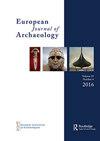晚上古时期莱茵河下游黄土平原的布吉
IF 1.4
2区 历史学
0 ARCHAEOLOGY
引用次数: 0
摘要
罗马晚期日耳曼尼亚省(Germania Secunda)腹地的防御基础设施依赖于布吉的广泛使用。这些防御定居点在改造别墅庄园、人口稀少地区和扩大军事足迹方面发挥了作用。它们在3世纪晚期和4世纪的景观中很常见,遍布比利时、荷兰林堡和莱茵兰的黄土带,但很少有人对它们进行量化。这篇文章致力于布吉的年代学、形态和功能方面,主要是在莱茵河下游地区的黄土平原。作者收集了来自各种各样的burgi的数据,对它们进行了表征,并就它们在景观中所代表的东西得出了有意义的结论,希望它能作为该领域未来工作的试点项目。本文章由计算机程序翻译,如有差异,请以英文原文为准。
Burgi in the Loess Plain of the Lower Rhine Region in Late Antiquity
Defensive infrastructure in the hinterland of the late Roman province of Germania Secunda hinged upon the widespread use of burgi . These defended settlements played a role in transforming villa estates, depopulated zones, and the expansion of the military footprint. They are common in the late third- and fourth-century landscape, spread throughout the loess belt of Belgium, Dutch Limburg, and the Rhineland, yet little has been done to quantify them. This article is dedicated to the chronology, morphology, and functional aspects of burgi , primarily in the loess plain of the Lower Rhine region. The author assembles data from a wide variety of burgi , to characterize them and reach meaningful conclusions about what they represent within the landscape, in the hope that it will act as a pilot project for future work in the field.
求助全文
通过发布文献求助,成功后即可免费获取论文全文。
去求助
来源期刊

European Journal of Archaeology
ARCHAEOLOGY-
CiteScore
3.40
自引率
6.70%
发文量
58
期刊介绍:
The publication organ of the European Association of Archaeologists, the European Journal of Archaeology seeks to promote open debate amongst archaeologists committed to a new idea of Europe in which there is more communication across national frontiers and more interest in interpretation. The journal accepts not only new empirical data and new interpretations of the past but also encourages debate about the role archaeology plays in society, how it should be organized in a changing Europe, and the ethics of archaeological practice. All periods are covered; papers, review articles, interviews and short "debate" pieces are all sought. Whilst English is the primary language of publication in the EJA, papers submitted in French or German will be given equal consideration.
 求助内容:
求助内容: 应助结果提醒方式:
应助结果提醒方式:


